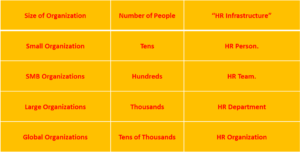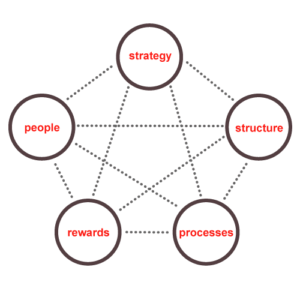The basic message here folks: organizational design is a lot more complicated than one might think. We’re hoping Organimi helps in that process.
In last week’s blog, we described some of Organimi’s new features. We invited users to “let thousands of org charts bloom”.
But we also recognize there is a “be careful what you wish for” aspect to that comment.
Making it easier to create and manage org charts and photoboards may help HR and IT professionals get things done faster. And being able to share these results in real time may also help everyone on the team connect, communicate and collaborate more effectively.
But we’ve all experienced the challenge of keeping on top of the “new ways of doing things” that were supposed to make our lives easier. Just think of overstuffed email inboxes, always on smartphones, and the tsunami of social media messages swamping us all every day!
How often should your org charts be getting updated? Last week we did a LinkedIn poll asking users just that. The consensus seemed to be that monthly to quarterly was fine, and that if you were doing it more frequently than that, it was likely the indicator of people problems, behind you, ahead of you, or both.
One poster commented that “if you’re adding managers to the chart more often to the point of updating more often, it’s time to reevaluate your personnel practices. Also if you are adding executive positions at that level, it’s time to revisit your business model”.
Feel free to give us your thoughts. The poll is running for another few weeks.
This week we’re talking about organizational design – the planning and strategy considerations behind org charts; why design choices are necessary, what some of the common choices for organizational structures are, and what they imply.
Next we’ll move on to talk about the pros and cons of these organizational design options, and their costs and benefits to the organization and its members.
Then we’ll wrap up this segment by talking about the emerging trend towards virtual teams and virtual organizations, and explore how organizations may be impacted by the changes they bring to organizational design. (You can read our white paper on Virtual Organizations if you want to learn more about that trend.)
So, for this week……the summary is
- Org charts are really a by-product of the organizational design process.
- Organizational design is quite important, and the implications of alternative design choices can be long-lasting, so you need to be aware of the options, and do your diligence and planning when you start, or before you make changes.
- There are some common patterns as well as some best practises on what to do and what to avoid, so we point to some of these resources.
One of our co-founder Brett’s most often-repeated mantras is that organizations spend a lot of time, effort and energy thinking about and setting up their organizational designs..…..so it should go without saying that having tools like Organimi that help you leverage, share and build on all this hard work should make a lot of sense.
We hope you also find Organimi a useful tool for the design work you are continually being asked to do!
Org Charts: A Lot More Than Butts and Boxes
When we started Organimi, I had an interesting conversation with a senior HR manager as we were working through some of our early product ideas.
She had extensive experience in both financial services and technology industries. She loved the idea of easier to use organizational modeling tools, but she also spent a fair bit of time with us emphasizing the importance of organizational design – the principles behind the org charts themselves, and the consequences of the design choices we make on the way our organizations evolve.
She noted that the process of organizational design is incredibly important; as is the selection of one type of organizational structure over another; since the choices themselves have significant impact on everything from organizational effectiveness, cost structure, and profitability, through to culture. That thought stuck with us. Most people outside of HR don’t think about that too much.
More recently, this idea was expressed succinctly by Dr. Carl Robinson in an online blog on Best Practises in Organizational Design when he noted that org charts and org design are about a lot more than “butts and boxes”.

Like many other management terms, “organization design” does not have a common, well-accepted definition. Robinson refers to it as “a structured and analytically driven systems approach to configure an organization to foster achievement of valued business, customer, and employee outcomes”.
Where Do We Start With Organizational Design? Size Matters!
So how does one go about doing organizational design properly? For us, the process of organizational design starts with the basic point that size matters.
 This can be seen in the basic resource allocations we make available to managing structure and relationships in organizations. The basic notion that HR resources themselves (the time, effort, energy and resources available to devote to these issues) are directly correlated with organizational size is hardly surprising.
This can be seen in the basic resource allocations we make available to managing structure and relationships in organizations. The basic notion that HR resources themselves (the time, effort, energy and resources available to devote to these issues) are directly correlated with organizational size is hardly surprising.
In his 2001 book Good to Great: Why Some Companies Make the Leap and Others Don’t Jim Collins explored the notion of whether or not there was an “optimal size” of organizations to maximize business performance. I vaguely recall the number was somewhere between 150 and 250 people according to some of the research he cited. Not sure that number leaves a whole lot of room for investing in HR resources. How many organizations with 150 people in them have dedicated HR resources? Not enough, likely.
The question of the optimal size of a company for business performance may have academic interest, but the reality for business leaders and HR managers is that your organization’s size “is what it is”. Collins makes that insight in passing, and proceeds to discuss the structural steps organizations need to take and strategies they need to follow to get from being good to being better. Even if he didn’t describe it that way (“getting the right people in the right seats on the bus moving in the right direction…”) some of the key ones related to organizational design.
We also know that regardless of size, some basic truths about people make organizational structure more important as the organization grows. As the size of groups increase……
- The opportunities for connections grow, making relationships more complex to both cultivate and manage.
- Needs for leadership becomes more evident, including needs for motivation, goal setting, planning, problem solving, and conflict resolution.
- The “trust” factors that influence organization and action in smaller groups tend to be replaced by structure, process, and leadership to deal with resource allocation, communication and consensus building.
So size matters and organizational growth requires more complex organizational design.
But we also know the “cost issues” impact on what is feasible.
Despite the platitudes often heard in the executive suite, at town hall meetings, and during retirement parties about the importance to the organization of the people who are “riding the elevators every day”, most HR professionals struggle for resources because of the continuing and enduring perceptions that HR is primarily a cost center.
The role of HR and its contribution to the business are, as always, an active source of discussion and debate. As Amy Kates noted in her work (Re)designing HR, this issue of optimizing organizational design resonates even within the HR department itself in larger organizations.
Our self-interested question at Organimi is whether we can bring useful analysis, modeling and engagement tools to organizations at lower cost, and, if so, will they bring enough value to justify their use. We think the answer lies, in part at least, on how well we help promote better organizational design.
Organizational Design: Keeping Tabs On Changes In Dynamic Systems
A second foundational consideration for organizational design relates to the dynamism of the organization.
Organizations that are “static” – definitely smaller ones (and perhaps even some very large ones) — have reduced needs for or emphasis on organizational design. We know these organizations; the players stay largely the same. Over time individuals within the organization become as well known to each other as they want or need to be. These organizations are typically very mature, they have existed for long periods of time, with deeply entrenched cultures, and well understood patterns for communication and execution of activities.
But for us these organizations are the exception rather than the rule. Most organizations are in a constant and dynamic state of change, growing at faster or slower rates, adding staff, acquiring or shedding personnel and entire business units.
With over 50 million people in America changing organizations every year, and attrition rates in large organizations amounting to hundreds of employees every year, millions of changes are happening in organizations across America and globally every day.
As our survey results showed, organizational structures do change on a regular basis and it is good practise to be able to keep the org charts updated to reflect these changes, at least on a monthly to quarterly basis for most.
Put another way, the best organizational designs don’t matter if everyone is in the dark about them.
Types of Organizational Designs: The Star Model
If one goes searching for “best practices in creating org charts”, the results are pretty thin gruel.
If you change the search parameters slightly to explore “best practices in organizational design”, however, you come across much more fertile ground.
Dr. Jay Galbraith is an internationally recognized expert and consultant on organizational design.
His Star Model™ is one of the most commonly cited frameworks for organizational design.

This model integrates a holistic view of strategy, structure, process, rewards and people, with a view to ascertaining which principles should be followed in establishing an effective design for your organization.
As Dr. Galbriath notes “the organization is not an end in itself; it is simply a vehicle for accomplishing the strategic tasks of the business. A well-designed organization helps everyone in the business do her or his job effectively. A poorly-designed organization (or an organization by default) creates barriers and frustrations for people both inside and outside the organization.”
There are 5 common models or patterns commonly followed for organizational design in creating an organizational structure:
- A functional approach (organize by department)
- A deliverables approach (by product or service category)
- A market approach (by industry or market served)
- A geographic approach (by region or territory)
- A process approach (by customer acquisition, product development etc.)
Each of these design choices is supported in Organimi. And we recognize that many organizations will employ a hybrid approach, combining multiple organizational designs to address the perceived strengths and weaknesses of each type. So we support some interesting integration and combination of these designs.
Considerations Driving Evolution and Change In Organizational Design
As we noted at the outset, having the ability to make changes in organization structure is one thing. Actually doing it is quite another. In his post, Robinson outlined some of the scenarios where organizational design is commonly reviewed. There is a good argument for design review and refinement in the following scenarios for example:
Strategy Changes
These triggers may be internal (a new product introduction, or geographic expansion) or external (competitor actions, a new and disruptive market entrant, or industry trends).
Organizational Changes
These triggers may be missing expected performance targets, or operational challenges in the business that impact on performance, or indications of poor alignment across teams that are affecting performance.
Operational Changes
Certain organizational structures more readily lend themselves to alignment around businesses experiencing steady or declining volumes, while others work particularly well in environments where transaction volumes are significantly increasing.
Managerial Changes
New leaders frequently use organization design as an initiative to “shake up” or transform the organization, including eliminating obstacles or rivalries that impede the achievement of desired objectives.
Our hope at Organimi is that having an organizational design system that supports these types of use cases will help time constrained HR and IT personnel support the needs of the business in all circumstances and at all times.
Avoiding Change For The Sake of Change
Last but not least, we return to our comments at the outset of this blog.
Just because Organimi makes it easy to implement, display and share organizational changes doesn’t mean it should be at the top of your to do list every day.
 In Solving the Rubik’s Cube of Organizational Structure, Ron Ashkenas notes how dysfunctional or outdated organizational designs can make it difficult for managers to operate effectively. He cautions, though, about how it is important to avoid the temptation to reorganize since this inevitably makes most organizational structures more complex and opaque…with “multi-dimensional matrix structures where decision-making is torturous and unclear; siloed functions that underleverage people’s efforts; or serial reorganizations that create constant uncertainty.”
In Solving the Rubik’s Cube of Organizational Structure, Ron Ashkenas notes how dysfunctional or outdated organizational designs can make it difficult for managers to operate effectively. He cautions, though, about how it is important to avoid the temptation to reorganize since this inevitably makes most organizational structures more complex and opaque…with “multi-dimensional matrix structures where decision-making is torturous and unclear; siloed functions that underleverage people’s efforts; or serial reorganizations that create constant uncertainty.”
Ashkenas suggests as few alternatives:
“Work with the current structure: Managers love to reorganize when results are not what they need to be. After all, it’s a convenient way to create the appearance of taking decisive action to reduce costs, refocus priorities, etc. But often this just creates more complexity. Most organizations can be made to work if leaders set the right goals, hold people accountable, streamline end-to-end processes, and put in place appropriate disciplines. In the absence of these (and other leadership actions) any structure can appear to be dysfunctional.
Make sure that structure is aligned with strategy: It seems obvious that organizations should be designed to advance business strategies. But many times strategies evolve and change while seasoned managers clutch tightly to their old ways of structuring their units and organizing their teams.
Structure around purpose instead of personalities: While organizational structures are usually portrayed as sets of interconnected boxes, the reality is that the boxes contain human beings with strengths, weaknesses, and personalities that often don’t fit with the logic of the organizational design. But instead of directly dealing with those “misfits,” most managers make accommodations to the design of the organization. This leads to structures that don’t quite work as they should.”
He closes with three good questions any manager should ask before starting to initiate a reorganization process for their business:
(1) Is the problem the structure, or the way we are managing it?
(2) Does the structure match our strategy?
(3) Has our organization design been compromised by accommodating specific personalities?
Intangible Aspects of Organizational Design: Creating Channels for Conversation
Lastly, we think that as a process the concept of organizational design is evolving, for the better.
Good organizational design, for example, increasingly considers the intangibles — the way the organizational structure facilitates or impedes the flow of communication and information in all directions across the organization; or the way organizational structures can facilitate or impede innovation.
We have all heard the references to “business silos” with their negative impact on business performance and organizational alignment. Many have seen them in operation.
In Galbraith’s star paradigm the people and technology enablers are both changing as we explore new types of working arrangements and new ways of relating to each other in the workplace.
The idea of promoting more effective bottom-up conversations and information through the organizational structure, as opposed to the traditional command and control form of top down communication customarily followed in large organizations, has been noted by Boris Groysberg and Michael Slind. In their book, Talk Inc.: How Trusted Leaders Use Conversation to Power Their Organizations, Groysberg and Slind suggest that organizations should follow organizational design principles that promote the flow of information in a conversational paradigm across the organization.
As they note, “in an economic environment where there is so much uncertainty, the senior management of a company might not know where the company should be going in three years. But your frontline customer-facing people might. Having communication that goes bottom-up is just as important as having communication that goes top-down.”
Their work advocates an approach called “organizational conversation,” which applies to all processes a company uses to circulate information across the organization, rather than just from the top down. “It’s about creating a culture in which the communication function becomes something that more and more resembles the way that two friends would talk.” Here we can see the value of enabling communication inherently within the organizational structure itself.
They see these types of solutions as creating effective channels to maintain and active conversation, such as internal blogs (in which leaders share their thoughts and employees have a chance to comment), wikis (which enable collaboration on corporate databases), online communities (which help far-flung employees find like-minded colleagues), Twitter (which lets employees broadcast information widely, both internally and externally), external social networks such as Facebook and LinkedIn (which enable information sharing among a particular group), video sharing (YouTube and the like), and web-enabled video chat (which help to mimic in-person communication).
If creating more meaningful communication involves issues of intimacy, interactivity, inclusion and intentionality, as they suggest, and if this resonates with you, the convergence of social, mobile and cloud technologies at the heart of Organimi may prove useful in promoting conversational interactions across teams in your organization.
That’s what we mean at Organimi by working to connect and engage people at work and play, across all the organizations they belong to.
Where To Next
We hope the resources we’ve referenced above give you some insights into organizational design – the how tos and to dos behind the organizational structuring (and restructuring) you may be engaged in or considering.
We also hope that you’ll find Organimi a useful tool for you in staying on top of the inevitable changes in design and in people that you need to deal with in today’s dynamic workplaces.
In coming weeks, we hope to cover the organizational structures most commonly adopted and their strengths and weaknesses. We also will talk about the growth of virtual teams and virtual organizations and the impact these trends may have on organizational design patterns.
Thanks for using Organimi. We hope you’re having fun…but not too much fun….with us!
The Organimi Team.

